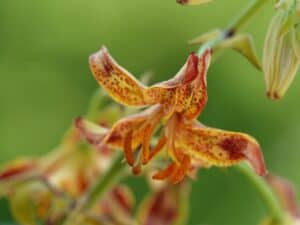Lilium parvum

Unleash the Tiny Tiger: Propagating the Charming Lilium parvum
The world of lilies bursts with flamboyant colors and intoxicating scents, but tucked within this vibrant array resides a miniature marvel: the Lilium parvum, also known as the Sierra tiger lily or alpine lily. These petite beauties, hailing from the western mountains of North America, pack just as much charm as their larger relatives, boasting clusters of delicate, downward-facing, orange blossoms delicately speckled with maroon.
While admiring their beauty in the wild is a treat, why not invite the Lilium parvum to grace your own garden? Propagating this captivating lily might seem like a challenge, but with a bit of patience and the right techniques, you can successfully multiply your floral treasures.
Let’s explore the two primary methods of propagation for Lilium parvum:
1. Seed Propagation: A Journey of Patience and Reward
For those who relish the entire journey from tiny seed to blossoming wonder, seed propagation offers a satisfying experience. Be aware, however, that Lilium parvum seeds require a period of cold stratification to break dormancy and mimic their natural growth cycle.
- Collecting Seeds: Collect ripe seed pods in late summer or early fall after the flowers have faded. Allow the pods to dry completely before gently crushing them to release the seeds.
- Stratification Process:
- Method 1: Sowing in Fall: Sow seeds directly outdoors in fall, about an inch deep in well-draining soil. Winter’s chill will naturally stratify the seeds.
- Method 2: Indoor Stratification: Place seeds in a moistened paper towel inside a sealed plastic bag and store in the refrigerator for 6-8 weeks.
- Sowing: After stratification (or in spring if sown outdoors in fall), sow the seeds in seed trays or pots filled with a well-draining seed starting mix. Cover lightly with soil and water gently.
- Patience is Key: Germination can take several weeks to months. Once seedlings emerge and have a few true leaves, transplant them to larger pots or directly into the garden.
2. Scaling: A Shortcut to Floral Abundance
For a quicker and often more successful method, scaling offers a great alternative. Scales are the fleshy, bulb-like structures that make up the lily bulb.
- Timing is Crucial: Divide the bulbs in late summer or early fall after the foliage has died back.
- Gentle Separation: Carefully dig up the parent bulb and gently detach the outer scales. Choose healthy, plump scales for best results.
- Preparing the Scales: Dust the base of each scale with a fungicide.
- Planting the Scales: Place the scales in a tray or pot filled with a mixture of perlite and vermiculite, burying them about halfway.
- Nurturing New Growth: Keep the medium consistently moist but not waterlogged. New bulblets should form at the base of the scales within a few months.
- Transplanting: Once the bulblets develop roots, they can be separated from the original scale and planted individually in pots or directly into the garden.
Important Considerations for Success:
- Well-Drained Soil: Lilium parvum thrives in moist but well-drained soil. Amend heavy clay soils with organic matter before planting.
- Sun or Shade?: Choose a location with partial shade to full sun, mimicking its natural habitat along forest edges or meadows.
- Water Wisely: Keep the soil consistently moist, but avoid overwatering, which can lead to bulb rot.
Propagating the Lilium parvum may require an investment of time and effort, but the rewards are immeasurable. Watching these miniature lilies unfurl their delicate blooms will not only add a touch of wild beauty to your garden but also fill you with a deep sense of satisfaction, knowing you played a part in their creation. So, grab your gardening gloves and unleash the tiny tiger within your own backyard!